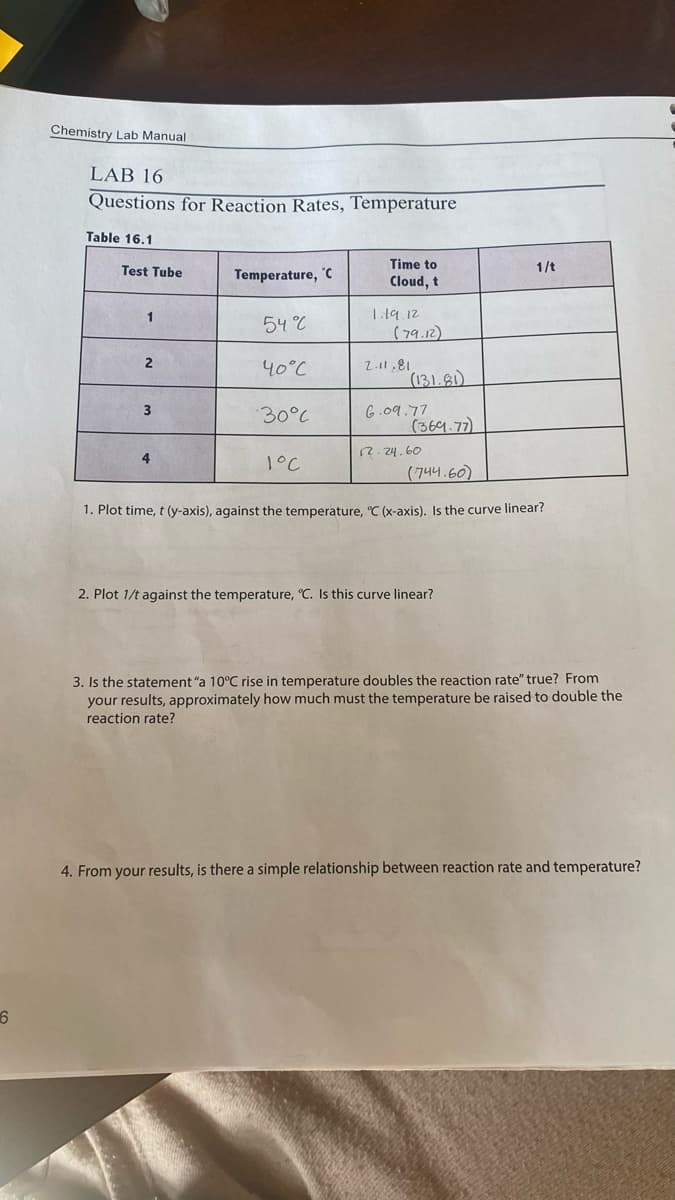1. Plot time, t (y-axis), against the temperature, C (x-axis). Is the curve linear? 2. Plot 1/t against the temperature, °C. Is this curve linear? 3. Is the statement "a 10°C rise in temperature doubles the reaction rate" true? From your results, approximately how much must the temperature be raised to double the reaction rate? 4. From your results, is there a simple relationship between reaction rate and temperature?
1. Plot time, t (y-axis), against the temperature, C (x-axis). Is the curve linear? 2. Plot 1/t against the temperature, °C. Is this curve linear? 3. Is the statement "a 10°C rise in temperature doubles the reaction rate" true? From your results, approximately how much must the temperature be raised to double the reaction rate? 4. From your results, is there a simple relationship between reaction rate and temperature?
Chemistry
10th Edition
ISBN:9781305957404
Author:Steven S. Zumdahl, Susan A. Zumdahl, Donald J. DeCoste
Publisher:Steven S. Zumdahl, Susan A. Zumdahl, Donald J. DeCoste
Chapter1: Chemical Foundations
Section: Chapter Questions
Problem 1RQ: Define and explain the differences between the following terms. a. law and theory b. theory and...
Related questions
Question
100%
My experiment I had five drops of Na2S2O3 and three drops of hydrochloric acid in each tube. Use the table for information to answer the questions below. Additional information if needed: hydrochloric acid = 0.1M and the sodium Thiosulfate (Na2S2O3) = 0.1M.

Transcribed Image Text:6
Chemistry Lab Manual
LAB 16
Questions for Reaction Rates, Temperature
Table 16.1
Test Tube
Temperature, 'C
Time to
Cloud, t
1
54%
(79.12)
2
40°C
(131.81)
30%
(369.77)
12.24.60
4
1°C
(744.60)
1. Plot time, t (y-axis), against the temperature, °C (x-axis). Is the curve linear?
2. Plot 1/t against the temperature, °C. Is this curve linear?
3. Is the statement "a 10°C rise in temperature doubles the reaction rate" true? From
your results, approximately how much must the temperature be raised to double the
reaction rate?
4. From your results, is there a simple relationship between reaction rate and temperature?
3
1.19.12
2.11.81
6.09.77
1/t
Expert Solution
This question has been solved!
Explore an expertly crafted, step-by-step solution for a thorough understanding of key concepts.
Step by step
Solved in 4 steps with 2 images

Knowledge Booster
Learn more about
Need a deep-dive on the concept behind this application? Look no further. Learn more about this topic, chemistry and related others by exploring similar questions and additional content below.Recommended textbooks for you

Chemistry
Chemistry
ISBN:
9781305957404
Author:
Steven S. Zumdahl, Susan A. Zumdahl, Donald J. DeCoste
Publisher:
Cengage Learning

Chemistry
Chemistry
ISBN:
9781259911156
Author:
Raymond Chang Dr., Jason Overby Professor
Publisher:
McGraw-Hill Education

Principles of Instrumental Analysis
Chemistry
ISBN:
9781305577213
Author:
Douglas A. Skoog, F. James Holler, Stanley R. Crouch
Publisher:
Cengage Learning

Chemistry
Chemistry
ISBN:
9781305957404
Author:
Steven S. Zumdahl, Susan A. Zumdahl, Donald J. DeCoste
Publisher:
Cengage Learning

Chemistry
Chemistry
ISBN:
9781259911156
Author:
Raymond Chang Dr., Jason Overby Professor
Publisher:
McGraw-Hill Education

Principles of Instrumental Analysis
Chemistry
ISBN:
9781305577213
Author:
Douglas A. Skoog, F. James Holler, Stanley R. Crouch
Publisher:
Cengage Learning

Organic Chemistry
Chemistry
ISBN:
9780078021558
Author:
Janice Gorzynski Smith Dr.
Publisher:
McGraw-Hill Education

Chemistry: Principles and Reactions
Chemistry
ISBN:
9781305079373
Author:
William L. Masterton, Cecile N. Hurley
Publisher:
Cengage Learning

Elementary Principles of Chemical Processes, Bind…
Chemistry
ISBN:
9781118431221
Author:
Richard M. Felder, Ronald W. Rousseau, Lisa G. Bullard
Publisher:
WILEY